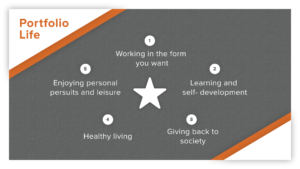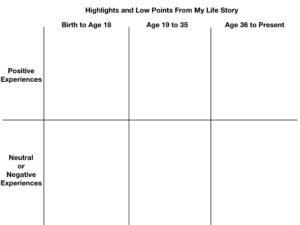Life & Work After 60… Create your future, guided by your past.
July, 2020
In this blog I will share some of the exercises I use to coach clients over age 60. The most commonly expressed goal of these clients is to one day create a portfolio life, described in the graphic above and in my 2019 blog series. The exercises in this blog will help you create your own version of a portfolio life.
Here are three quotations that make the case for looking back before creating a plan for your future:
“Life is lived forward, but understood backwards.” Soren Kierkegaard, Danish Philosopher
“You can’t connect the dots looking forward.” Steve Jobs, Founder of Apple Computer
“If a glimpse of the future is possible, it must come from an intimacy with the present clarified by the great works of the past.” Robert Kaplan, Journalist
What have been the main themes of your life? Can you pinpoint your most instructive life lessons?
What is Your Life Story?
In the popular play Hamilton, one question is asked repeatedly, “Who writes your story?” While others will contribute and offer their interpretation of your story, ultimately you are the main author. How will you write your next chapter? That is the task in front of you. Start by looking back and connecting the dots from your life’s stories.
Exercise 1) Look back. Recreate the above worksheet to record your thoughts. For each of the three life stages within this worksheet, list the highlights and low points of that stage depending on how you feel about that experience. If unsure, put the experience below the line as a “neutral” experience. At the end of this inventory, you will have material to help you complete exercise two.
Exercise 2) If your life were a play, in three acts, what would be the storylines within each act?
Start this exercise by reading my blog about three key elements of your life and work: pleasure, engagement and purpose. If you prefer to get started right away, here are some brief definitions:
Pleasure: This is about being comfortable and having fun. Typically the satisfaction of these activities lasts for a short period of time. You may need to repeat the activities over and over to get more happiness from them.
Engagement: The word “flow” is a helpful way to understand this experience. The state of flow is best described as the moments when your abilities are well matched to a challenging task. You know you are in a state of flow when you lose track of time and are deeply involved with a project or activity in a positive way.
Purpose: The use of your abilities in the service of something outside yourself, or something larger than yourself. Purpose is driven by your core values and by what you really care about in life.
Act 1 is the story of your youth: Birth to age 18
Act 2 is the story of your young adulthood: Age 19 to 35
Act 3 is the story of your adult years: age 36 to now
For each of your three acts, answer these six questions:
1) What you did for pleasure?
2) What you did for engagement?
3) What you did for purpose?
4) Highlights from this chapter of your life.
5) Low points from this chapter of your life.
6) What you are learning about yourself, and how these insights might help you plan your future?
Exercise 3) Look ahead. What is your personal, professional & community vision? Try this visioning exercise. It takes place in two rounds. Round one involves asking three imagined 75th birthday guests of your choice what they would like to thank you for. These guests include one each from your personal, professional and community life. Each table guest can be one person, or a composite of multiple people. What do you hope each representative will be thanking you for? Document your thoughts.
Round two asks these same three people about today. What would each representative suggest you continue to do, and what would each suggest you change in order to achieve your 75th birthday vision? Please note when you do this exercise that each representative may be alive or not. After you are done, ask yourself, “What do I want to continue, and what do I want to change?” Again, document your thoughts.
Exercise 4) This exercise is about your ideas and plans for each of the five portfolio life elements. Include responses to the six items below when describing your future plan for each element. As you contemplate each question, think back to what you have learned from exercises one, two and three.
Five Portfolio Life Elements (linked to blogs)
2) Learning and Self-Development
4) Healthy Living (Mind, Body, Spirit, Financial and Relationship Health)
5) Enjoying Personal Pursuits and Leisure (Pleasure + Engagement + Purpose)
Six Questions For Each Portfolio Life Element
1) What is working, or has worked in the past, that I want to continue?
2) What I would like to change?
3) Who are my connections inside, and outside, of my network, that can help guide me to achieve this?
4) What small experiments can I try to determine if this will fit and be sustainable?
5) Based on reflections, connections, experiments and happenstance, what have I learned?
6) My long and short-term goals include …
Exercise 5) Begin this exercise by listing your long and short-term goals for each category (carry over from the 6th point in exercise 4). At the end of each time period (I suggest monthly) list your actions, results and reflections. Remember to keep track of your actions on an electronic or paper calendar for easier reference at the end of each time period. Below is an example that you can incorporate or modify.
Portfolio Life Goals, Actions, Results & Reflections (date range)
Working in the form I want
• Goals (long and short-term), set at the beginning of each time period, adjusted as needed.
• Actions, connections & experiments that took place in this period (check your calendar)
• Results & reflections, completed at the end of the time period.
Learning and self-development
• Goals (long and short-term), set at the beginning of the time period, adjusted as needed.
• Actions, connections & experiments that took place in this period (check your calendar)
• Results & reflections, completed at the end of the time period.
Giving back
• Goals (long and short-term), set at the beginning of the time period, adjusted as needed.
• Actions, connections & experiments that took place in this period (check your calendar)
• Results & reflections, completed at the end of the time period.
Healthy living (mental, physical, spiritual, financial, interpersonal)
• Goals (long and short-term), set at the beginning of the time period, adjusted as needed.
• Actions, connections & experiments that took place in this period (check your calendar)
• Results & reflections,completed at the end of the time period.
Leisure pursuits
• Goals (long and short-term), set at the beginning of the time period, adjusted as needed.
• Actions, connections & experiments that took place in this period (check your calendar)
• Results & reflections, completed at the end of the time period.
Next Steps
As you are completing these exercises, discuss your findings with others you trust to be a good sounding board for you. Looking back and making future plans can generate strong feelings. Don’t go it alone.
When you begin to take action, you will likely feel awkward in new situations, especially when new insights and progress take on an unfamiliar shape. Without the support and encouragement of others, you may retreat from growth opportunities, or misinterpret the responses of others. Who do you know that might serve this role for you? Consider a trustworthy advisor or friends who have successfully transitioned into their own version of a portfolio life.
Remain open to surprises and unusual opportunities along the way. Stanford psychologist, John Krumbholz, coined the term “planned happenstance.” Krumbholz believes that, “A satisfying career, and a satisfying life, is found through actively creating your own luck and making the most of new and unforeseen experiences.”
Summary
Begin your transition to a portfolio life by doing the first two reflection exercises described in this blog. After that, look ahead. Define your personal, professional and community vision (exercise three), then plan your next steps for each portfolio life element (exercise four), set your goals, document and evaluate your progress (exercise five.) Take action, be reflective and remain open to happenstance. As your transition unfolds, let your insights about your past interests, strengths and values be your filter and your guide. Create your future, guided by your past.



